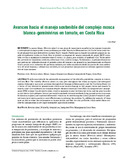| dc.description.abstract | La mosca blanca (Bemisia tabaci) es una plaga de importancia mundial, en las regiones tropicales y subtropicales. Aunque puede causar problemas por daño directo, en Mesoamérica y el Caribe actúa como vector de geminivirus muy destructivos en chile, frijol y tomate. Puesto que en tomate su combate químico no impide las epidemias virales, en Costa Rica se planteó un esquema de manejo integrado de plagas (MIP) orientado a evitar o minimizar el contacto entre el vector y la planta, para retardar la epidemia viral. Varios métodos preventivos (semilleros cubiertos, coberturas vivas, cultivos trampa, fertilización y repelentes/disuasivos) que podrían ser utilizados durante el período crítico del tomate a los geminivirus, han demostrado su eficacia total o parcial en la reducción del problema. Además, casi todos son inocuos desde los puntos de vista ambiental y de salud humana, y además son rentables, lo cual permitiría incorporarlos en sistemas agrícolas sostenibles de bajos insumos. The whitefly (Bemisia tabaci) is a key pest throughout the world, in tropical and subtropical regions. Although it may cause problems through direct damage, in Mesoamerica and the Caribbean Basin it is a vector of very destructive geminiviruses which cause serious damage to bell pepper, beans and tomato. In tomato, since viral epidemics are common despite chemical control, in Costa Rica an integrated pest management (IPM) scheme was devised to either avoid or minimize contact between the vector and the plant in order to slow down viral epidemics. Several preventative methods (covered seedbeds, living ground covers, trap crops, fertilization regimes, and repellents/deterrents) which can be used during the critical period of tomato to geminiviruses, have shown partial or total effectiveness in reducing the problem. In addition, the majority of them pose no risk to either the environment or human health, and they are also profitable, which makes them suitable for incorporation in low-input sustainable agricultural systems. | es_ES |


